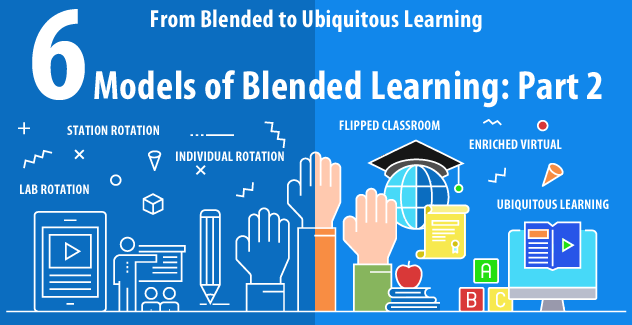
In this final post of this series on blended learning, we continue the discussion of the contexts for the implementation of blended learning and the different models which fit those contexts. As mentioned in the “Six Models of Blended Learning: Part 1” post, these models should not be understood as the only options for a given educational setting. What works best ultimately depends on the local conditions.
Here are the six models of blended learning which correspond to specific learning contexts:
- Blended learning model in elementary schools: Station rotation model
- Blended learning model in middle schools: Lab rotation model
- Blended learning model in high schools: Individual rotation model
- Blended learning model for higher education: Flipped classroom model
- Blended learning model for the workplace environment: Enriched virtual model
- Blended learning for mobile delivery: Ubiquitous learning model
In the previous post we discussed the first three of these. This post focuses on the others.
4. Blended learning in higher education
The flipped classroom model enables self-paced eLearning combined with hands-on and collaborative in-person meetings.
For most who teach at the college/university level, blended learning most likely automatically translates into the flipped classroom model. A station model is likely to be a poor fit due to the more limited contact time typical of college classes. Possible exceptions for which a rotating station model is feasible are in extended lab sessions or in compressed time formats such as intersession classes. For the typical college courses, the flipped classroom model offers the possibility of extracting the maximum learning leverage from both in-person meetings and digital learning environments.
In this model new learning content is presented through digital materials with which the students interact outside of class. To what extent this replaces in-person meetings will depend on the specific course, but typically this might involve for a common three credit course meeting in person two times a week instead of three. Optimally, the digital learning materials will be interactive and self-paced and incorporate abundant formative assessments. It is important that in working with the learning materials, each student can determine how well the content has been learned. Students work with the content in a self-monitoring mode and are able to review, fast forward, or bypass some content based on assessment scores, feedback, and their own evaluation of their progress.
Students come to class meetings having worked through new learning content, so as to be able to ask clarifying questions and, through discussions and class tasks, apply the knowledge learned. This takes full advantage of the classroom format to bring students together in small group work and for the instructor to be able to offer differentiated instruction.
5. Blended learning model for the workplace
The enriched virtual model supplies the flexibility needed in professional training environments, along with on-demand opportunities for interactions with trainers/instructors.
Although traditionally the enriched virtual model has been associated with high schools, it offers a good fit for professional or business training. In this model students work mostly independently, using digitized learning materials, but also have access to help when needed. Although typically no in-person class sessions are required, assistance is available either remotely—through either automated or human channels—and possibly in person at the place of employment or through the organization offering the training. This provides optimal convenience to trainees, as they only seek contact with trainers when needed.
Normally the content will be delivered by an online platform such as a learning management system (LMS). An essential component will be the ability to track student progress, as for this kind of learning, evidence of achievement will be needed. That is most likely to be done through a system that sends assessment results to the gradebook of the platform being used. SoftChalk-authored content, for example, uses the LTI standard to send results to an LMS gradebook.
6. Blended learning for mobile delivery
A ubiquitous blended learning model, delivered through mobile devices, offers the maximum degree of anywhere-anytime learning.
This model can be applied in any learning environment in which it is important that students have access to up-to-date learning materials wherever they may be. Increasingly, authoring tools such as SoftChalk create content that is mobile friendly. This allows learners to interact with content at the time and place of their convenience. That might mean having a regular commute on a bus or a train turn into a learning opportunity. If mobile access is likely to be important for specific course or required training, it is advisable to have learning content available in formats that work well on phones. That means, for example delivering the content in smaller chunks and avoiding any content, such as lengthy videos, with long load times.
It’s not the case that focusing on mobile delivery automatically means that this model bypasses the classroom. We are seeing more instructors in all fields have students use mobile devices in class for activities such as polling (through apps like Kahoot or Google Forms). In other instances, students may use mobile devices to interact and collaborate in small groups. I recently wrote a white paper for Cambridge University Press discussing opportunities for using mobile devices for language learning both inside and outside of class. Allowing students to use their devices in class breaks down the barrier between school and life. Doing so aligns teaching practices with the real world, in which mobile technology is integrated into most spheres of work and leisure.
All blended learning models are likely to take advantage of the increasing ubiquity of online devices, from smartphones to wearable devices. Blended learning allows teachers and educational entities to extend the reach of instruction to well beyond the classroom. At the same time, offloading content delivery to digital environments frees up in-person meetings to be much more personal, interactive, and effective.

Leave a Reply